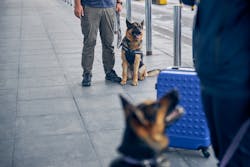Scent dogs detect COVID-19 in airports
Previous data suggest that scent dogs can discriminate between samples from individuals infected with SARS-CoV-2 and controls. Scent dogs showed high diagnostic accuracy in a randomized, controlled, triple-blinded validation test with sample size based on power calculations, according to a new study from researchers at the University of Helsinki and Helsinki University Hospital.
Scent dog detection can serve as a prescreening method to save time and resources or even as the sole testing method when other approaches are not yet available—for example, at the early stages of a pandemic.
To estimate scent dogs’ diagnostic accuracy in identification of people infected with SARS-CoV-2 in comparison with reverse transcriptase polymerase chain reaction (RT-PCR). A randomized triple-blinded validation trial was conducted at the Helsinki-Vantaa International Airport, Finland.
Four dogs were trained to detect COVID-19 using skin swabs from individuals tested for SARS-CoV-2 by RT-PCR. In a real-life setting the dogs screened skin swabs from 303 incoming passengers all concomitantly examined by nasal swab SARS-CoV-2 RT-PCR. Our main outcomes were variables of diagnostic accuracy (sensitivity, specificity, positive predictive value, negative predictive value) for scent dog identification in comparison with RT-PCR.
Overall accuracy was 92%, compared with RT-PCR tests. The dogs trained using the wild-type virus, performance was less accurate (89%) for the alpha variant for confirmed wild-type vs 36% for alpha variant. In the real-life setting, scent detection and RT-PCR matched 98.7% of the negative swabs.
This large randomized controlled triple-blinded validation study with a precalculated sample size conducted at an international airport showed that trained scent dogs screen airport passenger samples with high accuracy. One of our findings highlights the importance of continuous retraining as new variants emerge. Using scent dogs may present a valuable approach for high-throughput, rapid screening of large numbers of people.
Previous data suggest that scent dogs can discriminate between samples from individuals infected with SARS-CoV-2 and controls. Scent dogs showed high diagnostic accuracy in a randomized, controlled, triple-blinded validation test with sample size based on power calculations.
Containment of the COVID-19 pandemic necessitates rapid large-scale identification of infected individuals. Most patients with SARS-CoV-2 disease are either asymptomatic or have only mild symptoms but can be contagious. The test-and-isolate strategy has largely relied on the modern reverse transcriptase-polymerase chain reaction (RT-PCR) technique. Its practicality is hampered by inadequate availability, restricted testing capacity, high costs, long turnaround time, and prolonged positivity after infection. Rapid screening methods, such as antigen tests are already in use.
Dogs have an extremely sensitive olfactory system: their limit of detection reaches as low as one part per trillion concentrations, exceeding the instruments currently available. Dogs are presumed to detect distinct volatile organic compounds (VOCs) released by their hosts’ metabolic processes in various conditions. Indeed, dogs have been reported to identify distinct VOCs elicited by various bacterial, viral and parasitic infections.
During the current pandemic, scent detection dogs have been trained to identify samples from hospitalized patients with COVID-19. The preliminary data suggest that dogs can be trained within weeks to detect samples from SARS-CoV-2-infected individuals with an accuracy comparable to standard RT-PCR. However, stronger evidence is needed with power calculated sample sizes, better defined control groups, and above all, randomized double/triple-blinded research designs including previously unsniffed samples from the actual target population, outpatients. While proof-of-concept studies have been encouraging, scent dogs need to be taken from laboratory settings to real-life conditions.
